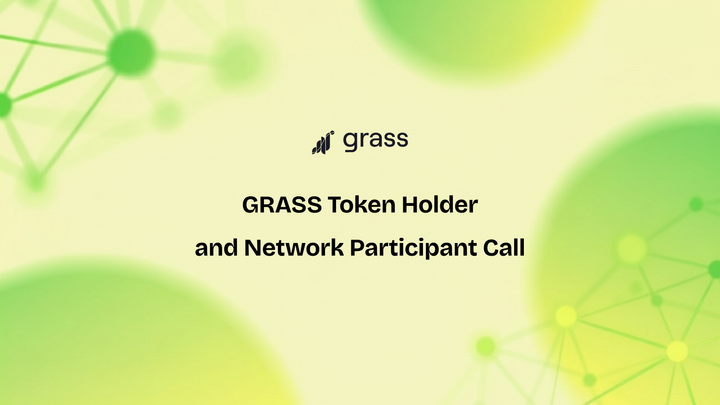The Intersection of Grass and AI Labs

From ChatGPT to Gemini, Grok, and more, AI tools are everywhere, with more applications on the way every day. Behind these powerful technologies lies a crucial need for massive amounts of data for training.
The AI labs behind some of your favorite AI tools need billions of data points from across the internet to develop intelligent models that can answer questions, generate content, and solve problems.
That’s where the Grass network comes in. By sharing your unused internet bandwidth through the Grass app, you help AI labs access the public web data they need while earning Grass rewards. And, not to worry, your personal data stays completely private.
Curious about how your extra bandwidth is helping train the AI tools you’re using every day? Let’s dive into the world of LLMs, word vectors, and big data.
What Are Large Language Models (LLMs)?
When you ask ChatGPT to create a dinner meal from the scant ingredients in your fridge or to compare the cost of a 2023 Mazda CX-30 to a 2024 Honda HR-V, you’re using a large language model (LLM). (Take a look at our Grass glossary to catch up on all the words you need to know.)
LLMs are sophisticated AI algorithms that are designed to “understand” and generate human language. However, these models don’t understand your desperate dinner request the same way a human would. Instead, they respond with predictive text based on patterns they learn through training.
Let’s use a simple example to see how LLMs learn in their unique, AI way. Imagine in your desire for a hearty dinner, you’re craving pasta with meatballs…but you can’t remember the specific noodle type you want. You hop onto a very basic LLM model and ask, “What type of pasta goes with meatballs?”
The LLM would search for a word that’s both a pasta and frequently appears with “meatballs” in its training data. The answer it’s most likely to get? “Spaghetti.”
Of course, more sophisticated LLMs, like Claude and Gemini, would likely give you many pasta options, but you get the picture.
LLMs and the Word Vectors They Produce
Behind every response you receive from an LLM is a fascinating system of “word vectors.” This is the actual “language” these models speak.
Our example of an LLM correlating “meatballs” to “spaghetti” was incredibly simplistic. In reality, today’s LLMs convert words into long strings of numbers that capture their relationship to other words and concepts.
In our example, the LLM might represent the word “spaghetti” as [1, 0.95] where 1 means “Yes, it’s pasta,” and 0.95 indicates its strong correlation to the word “meatballs.” While our simple pasta model used just two dimensions, actual language models use thousands.
Let’s give our fictional LLM a slightly more complex question: “What would a seven-year-old call spaghetti?” Suddenly, the model needs many more dimensions to capture age-specific speech patterns, regional variations, and pronunciation tendencies. The answer might be “sketti,” “basketti,” or something else.
As the questions we ask LLMs become more nuanced, the word vectors grow exponentially longer, requiring vastly more data.
Big Data: The Power Behind Advanced Language Models
Today’s AI labs are working to create incredibly refined LLMs, which requires them to create word vectors with far more than the two dimensions we highlighted in our spaghetti example.
Consider the word “Donkey.” In English, it only has six letters, but an LLM trained on Wikipedia would turn it into a string of over 5,500 numbers! This complexity allows LLMs to understand subtle relationships between concepts that simple correlations could never capture.
Why would an LLM assign so many numbers to a simple word like “donkey”? Because the model tracks the relationship between “donkey” and over 199,000 other words in its vocabulary. This dense web of connections enables the LLM to understand that donkeys are related to horses, used for transportation, mentioned in literature, and thousands of other nuanced relationships.
How can the AI labs behind today’s most popular LLMs find enough data to keep training and refining their models?
The Grass Connect: Empowering AI Labs with Data Scraping
The answer, of course, is Grass! While training LLMs on static data like Wikipedia is straightforward, capturing new information is much more challenging. How can AI understand current events, trending topics, new buzzwords, or changes in public sentiment? LLM models need data from constantly refreshed sources like social media, news sites, and forums.
That’s exactly what we’re here for. The Grass network serves as a critical middleware between AI labs and the vast public internet. When AI developers need to train their models, they partner with Grass to access our network of Grass nodes. Our sophisticated validator and router systems direct these data requests across our global infrastructure.
When you contribute your unused bandwidth through the Grass app, you become your very own Grass node in this ecosystem. (Cool, right?) Your connection allows AI labs to view web content from your geographic location, helping them gather diverse training data from the public web.
Crucial note: This Grass data never comes from your personal browsing history, files, or private information. The Grass desktop node you run only accesses public websites, never your private information.
The Grass rewards you receive represent your contribution to this global intelligence network.
The Future of LLMs and Your Role in It
In just the past few years, it’s been incredible to see how quickly LLMs and other AI tools have grown in complexity and functionality. As AI technology continues to evolve, language models will need vastly more data to continually improve their capabilities. Each new generation of AI will demand more diverse training data to enhance its accuracy and understanding.
The Grass network is positioned to be a valuable partner in the fascinating evolution of AI. By contributing to the Grass network, you’re not just earning Grass rewards—you’re also shaping the future of AI. Your individual Grass node enables AI labs to access crucial public web data, while the Grass app makes this contribution simple and seamless.
As cliche as it sounds, we can’t do this without you. Download the Grass app today and join our growing community of over 3 million users. You can also follow us on Discord to stay updated on the latest Grass AI development.
Join Grass today.


